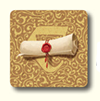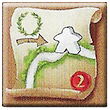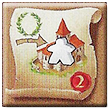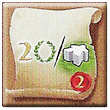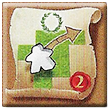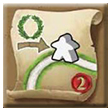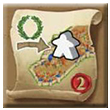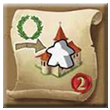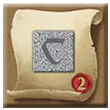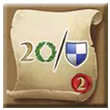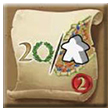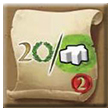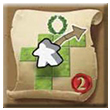The Messengers
 |
You are reading the rules for this tile design. |  |
 | Read the following rules if your tiles look like this. |
| If your tiles have a different design, then choose a game from Spin-offs. |  |
The King dispatches his faithful subjects into the realm. Wealth and prestige awaits any who make wise use of the messengers.
General info and comments

The Messengers (Mini #2) was released by HiG for the second edition, known as C2 for short, in 2017, bundled as part of ![]() Big Box 6. A third edition, known as C3 for short, was released in 2021 including more detailed graphics, cities with clipped buildings and some minor wording changes. The C3 version of this expansion is only available as part of
Big Box 6. A third edition, known as C3 for short, was released in 2021 including more detailed graphics, cities with clipped buildings and some minor wording changes. The C3 version of this expansion is only available as part of ![]() Big Box 7.
Big Box 7.
This expansion was originally released for the first edition, known as C1 for short, in 2012. In this edition it was known as The Messages or Dispatches.
Contents
- 8 message tiles
- 6 messengers in 6 colors
Rules
Preparation
Shuffle the message tiles and stack them facedown within easy reach of all players. Each player places the messenger of their color on the 0 space on the scoreboard. Each player should now have one meeple and one messenger on the scoreboard.
Gameplay
1. Placing a tile
There are no land tiles specific to this expansion.
2. Placing a meeple
The figures in this expansion are not placed on the standard land tiles as part of the game.
3. Scoring a feature
Whenever you score points, you must choose to move either your scoring meeple or your messenger forward along the scoreboard. If, during your turn (and only during your turn), your scoring meeple or your messenger moves to and stops on one of the dark spaces (0, 5, 10, 15, etc.) [1], immediately draw and resolve one message. To resolve a message, you must either:
- Perform the action shown on the message.
- Score 2 points (as shown in the bottom-right of the message tile.)
In both cases, the message tile is then placed facedown at the bottom of the stack.
The Messages Tiles
Other rules
- When you score points, you must move either your scoring meeple or your messenger accordingly. [11] [12]
- You can only draw one message from a round of scoring. [13] [14] [15] Even if both your meeple and your messenger land on dark spaces during one turn (by scoring two features), you will still only draw one message tile.
- Whenever tracking the points scored from a message tile earlier this turn, if either your scoring meeple or your messenger lands on a dark space, you may draw and resolve a second message. [16]
CAUTION: Only the active player can draw messages, therefore any other players with a scoring figure landing on a scoreboard dark space do not receive messages during another player's turn.
Final Scoring
At the end of the game but before starting final scoring, each player adds up the scores of their scoring figures (the scoring meeple and the messenger). Then each player places one scoring figure on their achieved total (and takes the 50-point and 100-point tiles obtained, if using them) [17] [18] and puts the other scoring figure back in the box. [19] No message tiles are drawn during final scoring.
Interactions with other expansions
If playing with other expansions, please take the following notes into consideration:
![]() Interactions with messages:
Interactions with messages:
- Message 1: A road with an inn on it is worth 0 points if it is incomplete.
- Message 2: A city with a cathedral in it is worth 0 points if it is incomplete.
- Messages 6 and 7: [20] The large meeple is counted as only 1 knight or farmer.
![]() Exp. 2 - Traders & Builders - Getting a double turn with the builder
Exp. 2 - Traders & Builders - Getting a double turn with the builder
![]() You can draw a message tile after each 3. Scoring a Feature action, so long as either your meeple or messenger is moving to and stopping on a dark space each time. [21]
You can draw a message tile after each 3. Scoring a Feature action, so long as either your meeple or messenger is moving to and stopping on a dark space each time. [21]
Tile distribution
C3 Edition
C2 Edition
Footnotes
For Icons explanation and licensing please visit Icons page.
- ↑
 In C2, the ZMG rules include an additional constraint not present in the original rules by HiG: You can only draw message tiles when your scoring meeple and messenger are alone. If another player's scoring meeple or messenger is on a dark space when you land there, you do not draw a message tile.
In C2, the ZMG rules include an additional constraint not present in the original rules by HiG: You can only draw message tiles when your scoring meeple and messenger are alone. If another player's scoring meeple or messenger is on a dark space when you land there, you do not draw a message tile.
This discrepancy was eliminated in C3. - ↑ 2.0 2.1 2.2
 The scoring for Messages 1, 2 and 3 only considers those points related to the feature. No bonus associated to any meeples placed on the feature are taken into consideration, since the focus of this message is scoring the feature. Those bonus points for meeples would be scored when the feature is properly scored.
The scoring for Messages 1, 2 and 3 only considers those points related to the feature. No bonus associated to any meeples placed on the feature are taken into consideration, since the focus of this message is scoring the feature. Those bonus points for meeples would be scored when the feature is properly scored.
- ↑
 This message would apply to all features considered proper monasteries:
This message would apply to all features considered proper monasteries:
- Monasteries
- Shrines / cult places
- Abbeys
- German monasteries
- Dutch & Belgian monasteries
- Japanese buildings
- Darmstadt churches
- ↑
 There is no official clarification stating whether this message should consider special monasteries (German monasteries, Dutch & Belgian monasteries and Japanese buildings) with a meeple placed as an abbot. The original rules were created before the special monasteries where released, so this case is not considered. However, the rules contain no limitations that would prevent players from considering special monasteries with a meeple placed as an abbot. In this case, we will apply the general rule provided by Georg Wild: "If an older expansion only mentions the word monk, this does not exclude meeples placed as an abbot on a German monastery." (7/2014) This will also apply to Japanese Buildings and Dutch & Belgian monasteries.
See:
There is no official clarification stating whether this message should consider special monasteries (German monasteries, Dutch & Belgian monasteries and Japanese buildings) with a meeple placed as an abbot. The original rules were created before the special monasteries where released, so this case is not considered. However, the rules contain no limitations that would prevent players from considering special monasteries with a meeple placed as an abbot. In this case, we will apply the general rule provided by Georg Wild: "If an older expansion only mentions the word monk, this does not exclude meeples placed as an abbot on a German monastery." (7/2014) This will also apply to Japanese Buildings and Dutch & Belgian monasteries.
See:
http://www.carcassonnecentral.com/community/index.php?topic=781.msg9971#msg9971
- ↑
 The placement of this tile follows a normal turn with all its phases. As indicated in another clarification, the placement of this extra tile may even become a double turn. The player may also receive additional messages.
The placement of this tile follows a normal turn with all its phases. As indicated in another clarification, the placement of this extra tile may even become a double turn. The player may also receive additional messages.
As in a normal turn, players may decide to use a tile in their supply instead of drawing a new one, such as:- An abbey tile (
 Exp. 5 - Abbey & Mayor)
Exp. 5 - Abbey & Mayor) - A German castle tile (
 Castles in Germany)
Castles in Germany) - A Halfling tile (
 Halflings)
Halflings)
- An abbey tile (
- ↑
 You will consider for Message 6 the number of your meeples placed in cities (knights): normal meeples, large meeple, mayor, wagon, ringmaster, guard meeples, phantom. Their strength (majority votes) is irrelevant.
You will consider for Message 6 the number of your meeples placed in cities (knights): normal meeples, large meeple, mayor, wagon, ringmaster, guard meeples, phantom. Their strength (majority votes) is irrelevant.
Note that abbots cannot be knights. Any meeples placed on a monastery within a city will be monks and will not be counted as knights. These are examples of monasteries within a city from Exp. 3 and Exp. 8 where a monk can be placed within a city:

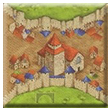
- ↑
 The ZMG rules allowed the active player to score a feature even without having the majority. This may be due to a mistranslation of the German rules.
The ZMG rules allowed the active player to score a feature even without having the majority. This may be due to a mistranslation of the German rules.
- ↑
 Note that you can score 0 points. This scenario may cover:
Note that you can score 0 points. This scenario may cover:
- A highwayman on road with an inn
- A knight in city with a cathedral
- A knight on besieged city
- A farmer in field with no completed cities
- A mayor in city with no coats of arms
- A mayor on castle token
- A lord/lady on castle token
- You do not have the majority
- ↑
 Any bonus points associated to the meeple being removed will be scored as if at the end of the game, such as the fairy 3-point scoring bonus or the ringmaster bonus.
Any bonus points associated to the meeple being removed will be scored as if at the end of the game, such as the fairy 3-point scoring bonus or the ringmaster bonus.
- ↑
 Any other meeples belonging to you or other players remain on the feature, as it is still incomplete.
Any other meeples belonging to you or other players remain on the feature, as it is still incomplete.
- ↑
 In other words, both scoring figures are considered equally, with no differences between the two.
In other words, both scoring figures are considered equally, with no differences between the two.
- ↑
 If, for example, a city and a road are completed and scored by the active player, a different scoring figure (the scoring meeple or the messenger) could be moved for each feature. However, all points scored by that city must be moved by one scoring figure, and all points scored by that road must be moved by one scoring figure.
If, for example, a city and a road are completed and scored by the active player, a different scoring figure (the scoring meeple or the messenger) could be moved for each feature. However, all points scored by that city must be moved by one scoring figure, and all points scored by that road must be moved by one scoring figure.
- ↑
 The ZMG rules read "You can only draw one message when scoring features," what is less specific than the original ones by HiG.
The ZMG rules read "You can only draw one message when scoring features," what is less specific than the original ones by HiG.
- ↑
 This means that messages are received after 3. Scoring a feature. The round of scoring considers all the scorings taken place during a player's turn. Note that, during a double turn, there is one round of scoring per turn part.
This means that messages are received after 3. Scoring a feature. The round of scoring considers all the scorings taken place during a player's turn. Note that, during a double turn, there is one round of scoring per turn part.
- ↑
 The 1st edition of this expansion considered a more complex approach to Messages with several rounds of scoring accoring to the clarifications provided in 5/2014 and 10/2014, now rendered obsolete. The 2nd edition considers only one round of scoring after 3. Scoring a feature.
The 1st edition of this expansion considered a more complex approach to Messages with several rounds of scoring accoring to the clarifications provided in 5/2014 and 10/2014, now rendered obsolete. The 2nd edition considers only one round of scoring after 3. Scoring a feature.
 Question: You only receive a message if your messenger or your scoring meeple end up on a dark space after scoring all your points, right? I mean, you don't take into consideration any intermediate scorings due to several completed features, but only your last move of your scoring figures.
Question: You only receive a message if your messenger or your scoring meeple end up on a dark space after scoring all your points, right? I mean, you don't take into consideration any intermediate scorings due to several completed features, but only your last move of your scoring figures.
Answer: Yes, you only take messages with your last movement on the scoreboard. But there is a edge case: if you get points from the messages that grant you another message, you will get those as well. This mentioned in the Big Box 6 rules. (1/2021)
The mechanics associated to "rounds of scoring" in the previous edition are detailed here.
- ↑
 The 1st edition also indicated that if you get points from a Message, it is possible that you could move a scoring figure and receive another Message, playing it in the same turn. Chains of scoring in this way can continue indefinitely.
The 1st edition also indicated that if you get points from a Message, it is possible that you could move a scoring figure and receive another Message, playing it in the same turn. Chains of scoring in this way can continue indefinitely.
- ↑
 The ZMG rules omit this clarification.
The ZMG rules omit this clarification.
- ↑
The point tiles are included in
 Exp. 1 - Inns & Cathedrals, but the
Exp. 1 - Inns & Cathedrals, but the  Big Box 6 rules assume these tiles are part of the base game. This is the reason why they are mentioned here.
Big Box 6 rules assume these tiles are part of the base game. This is the reason why they are mentioned here.
- ↑
 The ZMG rules instruct players to use their scoring meeple for the final scoring and remove their messenger. The original HiG rules allow players to choose any of their scoring figures (either the scoring meeple or the messenger) for the final scoring and remove the other one.
The ZMG rules instruct players to use their scoring meeple for the final scoring and remove their messenger. The original HiG rules allow players to choose any of their scoring figures (either the scoring meeple or the messenger) for the final scoring and remove the other one.
- ↑
 This clarification referred to Messages 5 and 6 by mistake in the PDF rules available. The HiG printed rules corrected this error. In fact:
This clarification referred to Messages 5 and 6 by mistake in the PDF rules available. The HiG printed rules corrected this error. In fact:
- Message 5 refers to coats of arms.
- Messages 5 and 6 only refer to cities, so the mention of farmers doesn't make sense for any of them.
- Message 7 does involve farmers.
- ↑
 If a tile is added to a feature with a builder and triggers the drawing of Message #4, The Message extra tile comes before the builder extra turn. If the extra tile from the Message is put on the builder's feature, this will create another builder extra turn. Thus, the events would be: initial turn => Message #4 turn => Message #4 builder turn => original tile's builder turn. (11/2013)
If a tile is added to a feature with a builder and triggers the drawing of Message #4, The Message extra tile comes before the builder extra turn. If the extra tile from the Message is put on the builder's feature, this will create another builder extra turn. Thus, the events would be: initial turn => Message #4 turn => Message #4 builder turn => original tile's builder turn. (11/2013)

